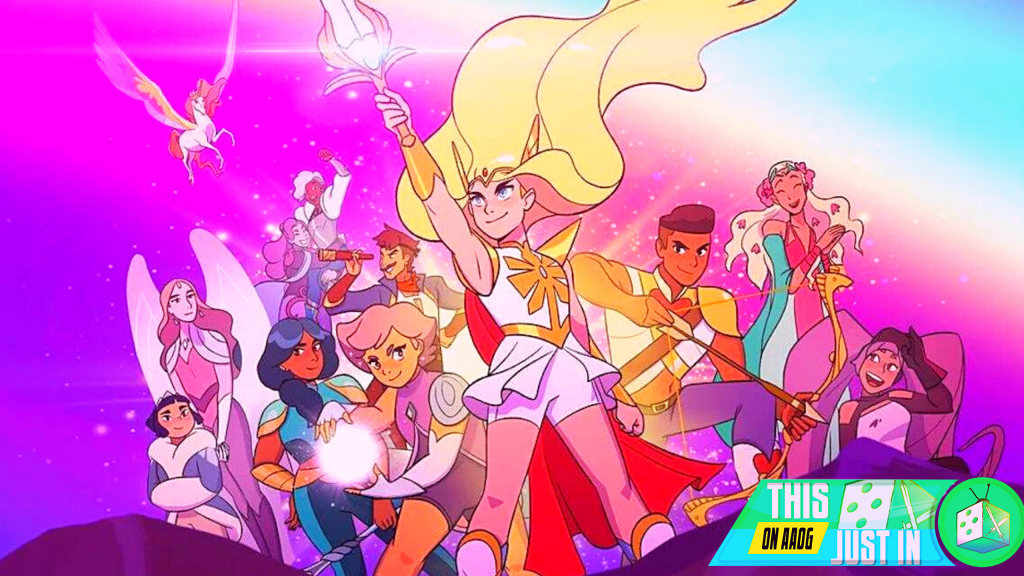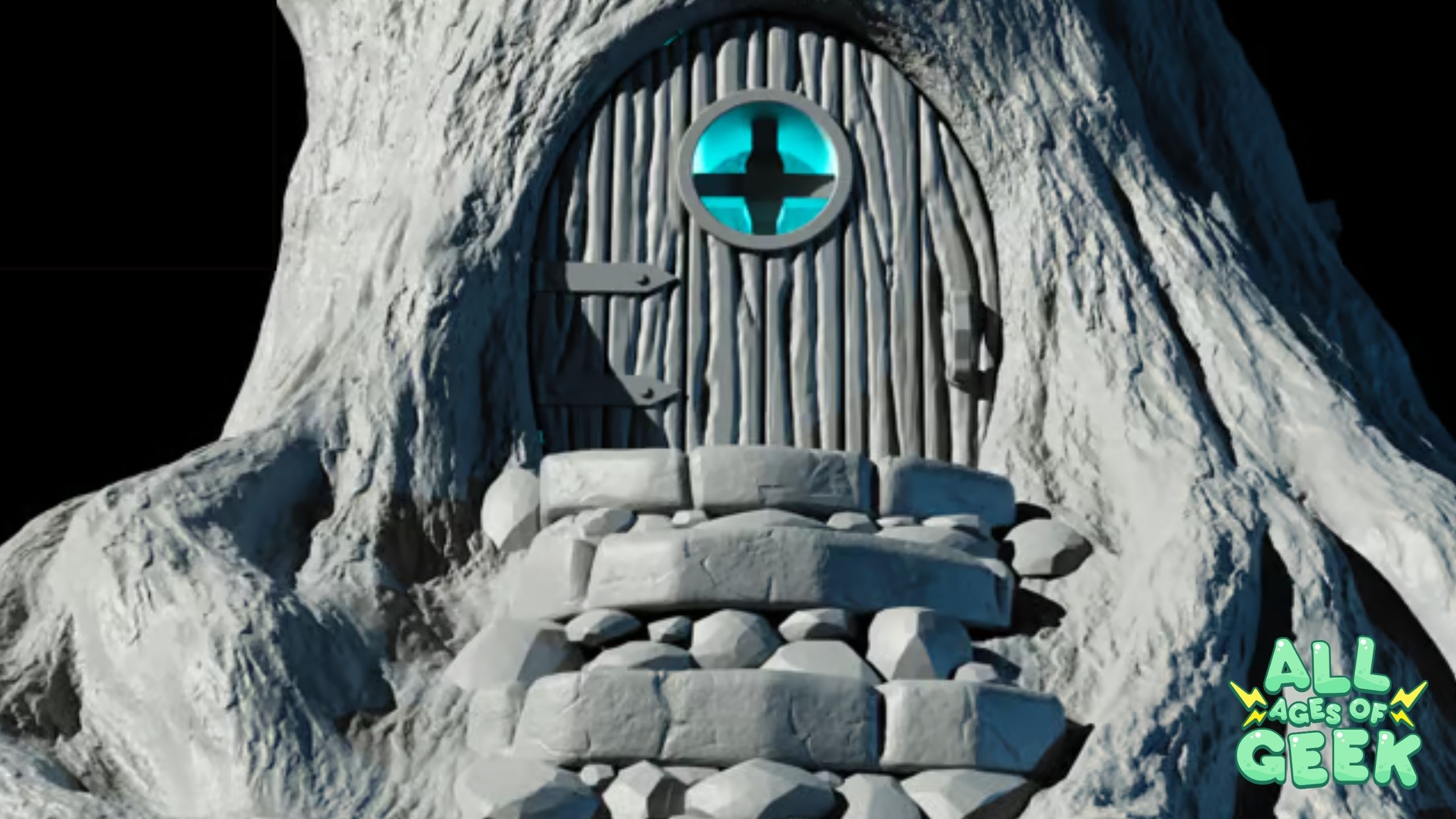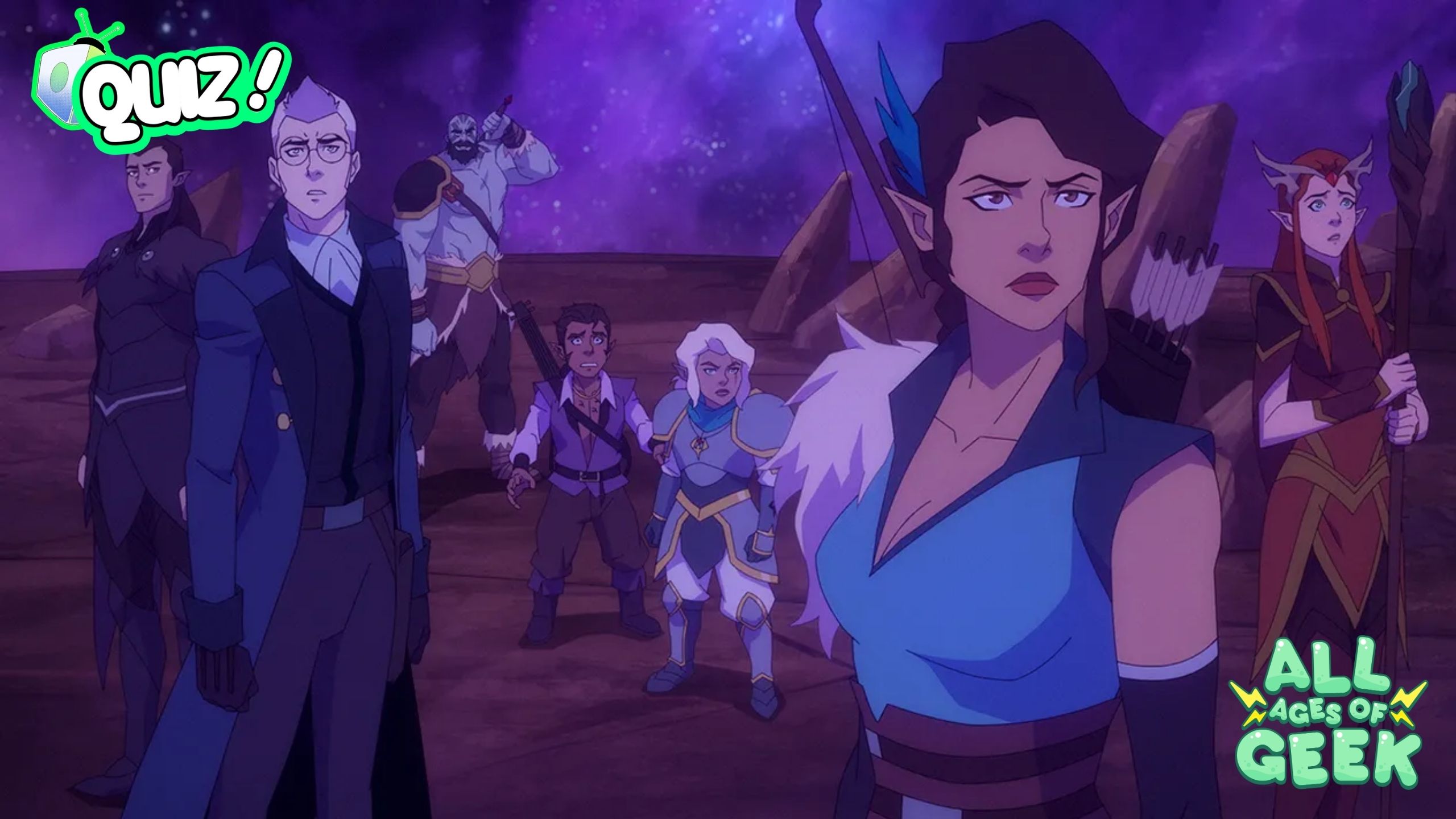(The following review contains unmarked spoilers. YOU HAVE BEEN WARNED!)
It was the year 2018, and Noelle Stevenson, the creator of Nimona and Lumberjanes, announced that she would be helming a new entry for the Masters of the Universe saga called She-Ra and the Princesses of Power. Pretty soon, the first images of She-Ra’s updated design were released on the Internet, and soon the weebs were soon embroiled in a hot debate over the attractiveness, or lack thereof, of the new design, with many people up in arms against each other. In one camp, you had people who grew up with the original She-Ra who complained that she was not attractive or glamorous enough like she was originally and that she was really just a dude in a wig. In the other camp, you had people countering that since this was a kids’ show, the showrunners wanted to avoid sexualizing the main character as much as possible. Hell, one of the original creators of She-Ra, J. Michael Straczynki, commented that She-Ra was “a warrior, first and foremost”, and that “anyone who is looking back at She-Ra (or Adora) as the “ideal woman” is doing so through the lens of prepubescent … interest and kind of, understandably, imprinted on her like baby ducks”. With both sides bringing up valid point against each other, you might be asking, what are my thoughts on this?
I’m gonna cut to the chase: I didn’t grow up with Masters of the Universe in my childhood, because the country that my family is from, India, is not familiar with He-Man or She-Ra. So how did I come across this show, you ask? I was recommended it on an Internet forum last year because I needed help with designing a fictional world that I hope to create in the future. So I decided to give it a whirl, and to my surprise, I actually wound up liking the show, so much that I decided to rewatch it again this summer, this time in Japanese. Of course, by the time I learned the shady business that had gone on behind the scenes, it was too late to stop watching it, because I was hooked. (I later decided to not let that business ruin my enjoyment.) And keep in mind that since SPoP was my gateway drug into the Masters of the Universe franchise, this review will be made from a neutral standpoint, completely free of any bias.
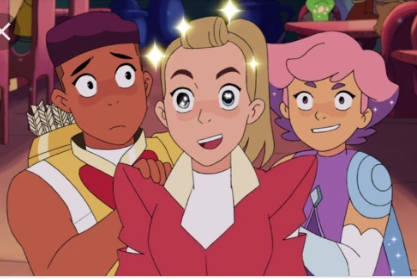
The characters
The new She Ra boasts an impressive display of characters with diverse personalities and distinguishing characteristics, and each of them are very well defined, with clear personalities and traits that make them memorable, and fun to watch. The two best characters are certainly Adora and Catra, with their relationships forming one of the core elements of the series. The other characters are fun, and no one can deny the representation they offer is important and valuable. A trap some series these days have a tendency to fall into is making a character’s LGBT status the only definable trait of the character, to the point they have no identity beyond being LGBT. That is thankfully not the case here, as each of them have their own distinct personality and their own personal arc within the series that they have to overcome. For example, the main character, Adora, has a deep and complex with Catra, one of the show’s most prominent antagonists (though not the main villain of the series), and she also later learns that her role as She-Ra was actually intended to by her ancestors, the First Ones, to activate an ancient superweapon known as the Heart of Etheria. Part of her character development is learning to accept that she is not a tool of destruction. Glimmer, meanwhile, is a reckless, stubborn, and impulsive girl who nevertheless means well, and in Season 4, after her mother’s tragic sacrifice, she matures significantly, and to go with that, she has a brand new character design that is less childish (quite fitting, as she has to become the new Queen of Bright Moon). Bow, meanwhile, is the heart of the Best Friends Squad (the group consisting of him, Adora, and Glimmer), but over time, it’s shown that being the emotional center of the team can take its toll on him, as in Season 4, after his two friends have a falling out, he tries his hardest to keep the peace before finally admitting to Sea Hawk that it is taking a lot out of him being the only one trying to keep their friendship from falling apart and that no one appreciates his efforts. Other than that, though, he doesn’t really achieve any sort of personal growth throughout the series, which is not necessarily a bad thing, since he’s one of the more well-rounded characters.
The Best Friends Squad is not the only group of characters to have interesting and deep characterizations. The other members of the Princess Alliance are rounded in terms of characterization as well. For example, Princess Perfuma is a hippie peacekeeper who would always try to seek a nonviolent solution to problems, but she eventually learns that violence sometimes has to be the answers to certain things. Another member, Princess Mermista, initially comes off as snarky and aloof, but it’s later revealed that she does, in fact, care about others, and she is later But for me, the most interesting member of the team was Entrapta, as she has a very quirky personality that sort of reminds me of myself (that is, she has less than perfect social skills but ultimately means well; in fact, it’s pretty much stated by her character designer that she’s autistic). One could hardly blame her for accepting the offer to join the Horde, as the other members of the Princess Alliance didn’t exactly make her feel welcome, plus, the Horde had lots of technology that she could experiment with. This may seem bad at first glance initially, but she later develops a relationship with Hordak, an antisocial warlord who is in command of the Horde, and her wholesome interactions with him have major ramifications for his character arc.

The villainous cast is also well-defined and diverse in terms of personality as well. Whether it’s the compassionate Scorpia, the deliciously evil Double Trouble (who is explicitly referred to as nonbinary in this continuity), Hordak, Catra (who is a fan-favorite), or even the three cadets Kyle, Lonnie, and Rogelio, viewers were bound to find a villain to sympathize with (the exceptions being Shadow Weaver or Horde Prime, who I’ll get into later). For me, I was more attached to Scorpia, as her character arc revolved around coming to realize that Catra was a pretty bad friend to her, especially after Catra had Entrapta exiled to Beast Island to prevent her from stopping the portal from being opened. I was also a fan of Double Trouble and their smug, mocking demeanor, as well as Horde Prime and his calm, stoic, almost royal demeanor, though I liked the three Horde cadets also. Each and every one of the voice actors nailed their roles perfectly, though the Japanese voice cast also pulled off their voice acting chops as well (believe me, it was a treat to get to hear the Japanese voices; it almost felt like I was watching an anime).
The Story

The first season sees Adora and her friends reassemble the Princess Alliance, which successfully defends the rebel stronghold of Bright Moon against the Horde’s assault. Meanwhile, Catra rises in the ranks to become Hordak’s second-in-command. In the second and third seasons, Hordak attempts to build an interdimensional portal which will allow him to contact Horde Prime. Catra activates the portal even though it threatens to tear the planet apart, and rebellion leader Queen Angella sacrifices herself to stop it. In season four, friction arises between Adora and Glimmer when Adora learns that her sword is the key to an ancient superweapon inside Etheria. While Catra convinces Hordak to be her co-leader of the Horde, Glimmer then attempts to use the superweapon to win the war, though, Etheria is pulled through a portal, becoming vulnerable to attack by Horde Prime’s armada. In order to prevent the weapon from activating, Adora destroys her sword, losing access to her She-Ra powers; in the confusion, Glimmer, Hordak and Catra are captured by Horde Prime.The fifth and final season follows Adora’s journey to liberate Etheria from Horde Prime’s reign. Adora rescues Catra and Glimmer from Horde Prime’s ship, rediscovering her She-Ra powers in the process, but in the meantime Horde Prime has subdued much of Etheria with his mind-control capabilities. The princesses and Catra (who decided to redeem herself) work together to disable Horde Prime’s hivemind and stop him from accessing Etheria’s ancient superweapon. In the end, while Hordak (who had a change of heart) turns against Horde Prime, it is Adora and Catra’s love for each other that enables She-Ra to destroy both the weapon and Horde Prime, and save the universe from his tyrannical reign.
Throughout my viewing of the series, I noticed that this show takes a lot of cues from Star Wars, seeing how the series focuses on a rebel princess fighting against an evil empire and whose enemy happens to be a loved one whom she tries to bring back to the light. That said, the series deconstructs the “chosen one” trope, as well as the mythical hero’s journey and quest for identity, in a way that is more relatable (see Adora’s character development in the previous section). If there is one thing I can say about this show, however, it’s that it REALLY highlights the shortcomings of the sequel trilogy in a way that no other series can. She-Ra shares many of the same ideas and themes that the ST does but puts those ideas front & center while avoiding all the issues I have with the ST.
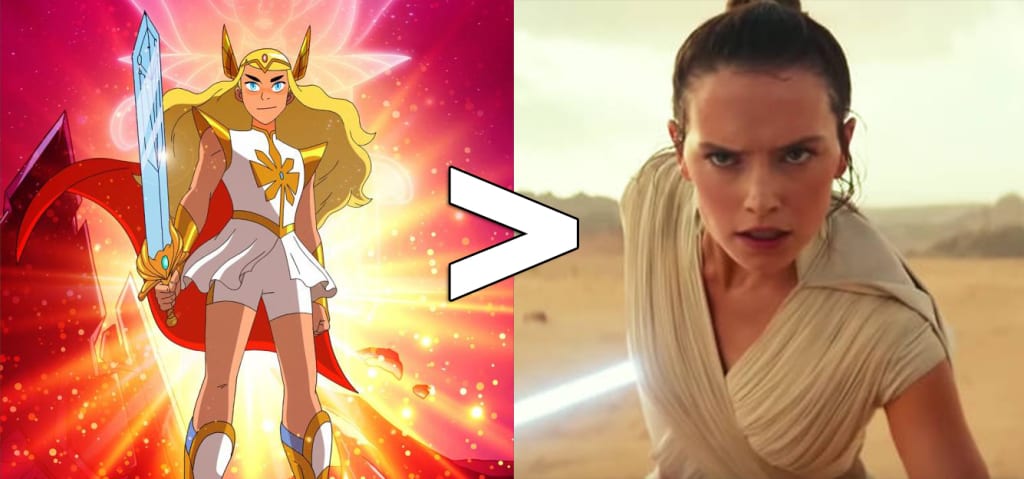
For example, She-Ra actually takes the time to flesh out its ideas and examine the fallout of each action the characters take. One of the problems with TDST is that it refuses to actually explore the consequences for its actions. None of the actions that happened in it matters, these ideas are never explored even a little bit and as a result the story has no real narrative weight. By contrast, Angella being exiled to another dimension had a huge impact on the character arcs of Adora, Glimmer, and especially Catra. Adora destroying the Sword of Protection plays a MAJOR role in her character arc in Season 5, and even Catra’s mistreatment of her loved ones and the abuse she receives from Shadow Weaver and Hordak is explored in depth and has a massive impact on the plot throughout the series.
In addition, the villains are allowed to be competent and the heroes are allowed to be flawed. In the years to come, Rey will likely be seen as one the weakest characters in Star Wars due to her lack of development, flaws and perfect battle record. Adora, on the other hand, will likely be seen as one of the best lead characters in the modern due to her VERY deep and complex character arc, her personal flaws, and the fact that she was allowed to lose a fight every so often (case in point being the fall of Salineas and the failure to recapture Dryl). Further, Kylo Ren will likely always be seen as a whiny twat who lost every major fight he was ever in and a Darth Vader wannabe. Catra, on the other hand, will likely be seen as one of the best redeemed villains along with Zuko who was an effective adversary who manages to score a number of victories against the heroes. And like Adora, she is also bolstered by a complex and deep character arc, personal flaws that help to shape her into an amazing character. It helps that as previously mentioned, the relationship between her and Adora forms one of the central focuses of the series. Which leads us to the elephant in the room: Catradora, one of the divisive ships in the fandom.
/cdn.vox-cdn.com/uploads/chorus_image/image/62622775/Screen_Shot_2018_12_03_at_3.36.23_PM.0.png)
I’ve come across people say that Catradora is toxic, with another camp arguing that it wasn’t. In the former, you had people pointing out how Catra abused and manipulated Adora and treated her like a possession. In the latter, you had people point out how they weren’t really in a relationship, and that they were bitter enemies, with one person pointing out how Catra was more of a standard war criminal than anything else. One person I’ve talked to on Discord actually gone on record saying that Shadow Weaver was responsible for how Catra turned out, and it’s kind of hard not to agree with him. But I’m just going to come out and say it: I was pretty neutral toward the ship happening, because that was not the main reason I watched the show. I also know for a fact that there are some other shows out there (including anime) with villains who’ve done things on par with or worse than what Catra has done, and yet the fandoms for those shows give them a pass. Part of me feels that Catra should be held to the same standards, but then again, who am I say? I’m just a nerd with internet access, who’s had no inkling of how relationships work. I will say this, though: I feel like Catra should have had more positive interactions with Adora before they got together as a couple. I can only hope that Catra continues to work out her issues with Adora while they’re in that relationship.
As for the story, well, it has a similar problem to what I mentioned earlier, in that they there are clear plot points and characters they prioritize, such as Catra and Adora’s relationship, which is done very well, but the problem there is that some elements (important ones at that) begin to take the backseat. For example, Catra’s redemption arc comes a bit too quickly in Season 5; for a point of comparison, Zuko’s redemption arc consisted of him being an antagonist in the first season, but the viewers get a clear set of motivations of him, which makes his struggles in the second season more meaningful, and his ultimate redemption in the third more dynamic. In contrast, Catra remains an antagonist all the way up to the last season, and her primary struggles are just with dealing with Adora being on the opposite side. That all said, her motivations are still believable, as is her redemption, but it’s definitely not one of the great arcs I’ve seen characters go through. In addition, the romances with the other characters aren’t given the proper attention to really flourish, and not all confessions seem entirely earned at the end. (Except maybe Entrapta/Hordak and Bow/Glimmer.)
Overall, though, any young kids watching the series can still pick up a few valuable lessons from the series (even though the morals aren’t as in-your-face as they were back in the day). For example, one very important lesson throughout the series is how no matter how bad your past is, you are still responsible for your own choices. Catra’s continual blaming of Adora for the problems that she (Catra) caused is what ultimately causes Adora to decide that Catra isn’t worth saving and cut off ties with her. Some of other lessons that kids can learn: relationships require reciprocal effort (even with their relationship on the rocks in Season 4, the Best Friends Squad still manages to hold their alliance strong, with Bow even giving Entrapta a speech on how friendships need both parties to give it their all); people are stronger when united (the Rebellion only begins to get successful when the princesses work together and they take losses when they are at their least united); sometimes it is necessary to defy the expectations of family, leaders, etc. in order to do what’s right; past traumas can hinder you, if you let them; true friends care about your well-being and support you during difficult times, while false friends merely use you to get what they want; people who denigrate others are often overcompensating for their own feelings of inadequacy; actions have consequences, no matter how well-intentioned those actions might be; people can change if you give them the chance, and it’s never too late to do the right thing; there is power in love and friendship, even though it isn’t easy to open your heart and be vulnerable; you can either indulge in power or have the love of your family/friends; and love, friendship, acceptance, and a place to belong are vital to a happy life. If those are not good life lessons one can get from this, I don’t know what are.
General things
/cdn.vox-cdn.com/uploads/chorus_image/image/66824380/CATRA__HORDE_PRIME__2_.0.jpg)
Some general things that I liked: First off, it looks great. I didn’t grow up with the original series from the 80s (honestly I’d be surprised if a lot of people who watched this series did), but I can say that the character designs do harken back to the originals, while still being their own thing. (Addressing She-Ra’s controversial redesign, while I understand wanting to make it more kid-friendly, I feel like they could have made it more feminine and less like a boy in a wig.) The world of Etheria is also pretty to look at, with a lot of different colors without getting to the point of being garish, thanks to the bright colorful artsyle, which reminds me a lot like Fullmetal Alchemist Brotherhood. (And for those of you arguing that it’s Cal-Arts, it doesn’t resemble any of those types of cartoons that I grew up with.) The animation also allows for some great shots, and some good fight scenes.
Not everything about the new She Ra was good, however. One of the things that miffed me a little about the reboot was the lack of redheads in the entire series. For a series that prided itself on being “diverse”, one would think that there would be at least one or two gingers in the reboot, like there was in the original. I know for a fact that both Bow and Sea Hawk were redheads in the original, and yet here, they are both the equivalent of African-American and East Asian, respectively. I will never understand what current year Western entertainment has against redheads, but there’s more I have to unpack.
A second thing I have against the show is that it can be inconsistent at times. Sometimes the animation can be cheap looking. Not to mention that in episode 4, Glimmer’s body size changes when she dresses up in Horde soldier armor, when she is normally very chubby, so to speak.
But what’s even more glaring is that near the end of the first season, Light Hope tells Adora that she must bring balance to the planet and find the remaining princesses while showing holographic representations of at least a dozen princesses, and yet by the end of the fourth season, no new princesses are found or added to the cast, meaning that the princesses needed for Light Hope’s plan essentially the five or so princesses that we see for the entire series.
But tying up is that the “final battle” of the series is rather anticlimactic. The final battle (if you can even call it that) between She Ra and Horde Prime is rather anticlimactic. Not once do Prime and Adora trade blows with each other. Instead, we get a rather short scene of Adora purging Prime’s spirit from Hordak And as anyone who has read my Fullmetal Alchemist article from earlier in the summer will know that I have a problem with rather dull final fights. Well congratulations, FMA, you’re no longer the top winner for “Worst Animated Final Fight Ever”. On a related note, it’s not known whether they will resolve the more important consequences of the fall of the Horde Empire (what will become of the stranded Horde clones, for example, and especially what will become of Angella and whether or not she can be saved from between dimensions).
Final thoughts

So to sum up, is this show worth your time? It is. In spite of all its flaws, it’s still an enjoyable show. Maybe not one of the greats, but it’s still enjoyable. Is this a perfect show? Hell no! Then again, I don’t think that the perfect show even exists (even Avatar: The Last Airbender had its problems). I am simply putting it out there that this show does not nearly deserve enough hate as it gets, and there are far worse shows out there (coughs in Teen Titans Go and Thundercats Roar, and especially the new Masters of the Universe: Revelations show). But at the end of the day, I think She-Ra sits comfortably as one of the great animated shows of the modern era, in spite of a few issues. As worst, it is a guilty pleasure of mine. In the end, I’d definitely recommend it, though it is understandable if one doesn’t want to see it. Overall, a solid 7.5 or 8/10.


